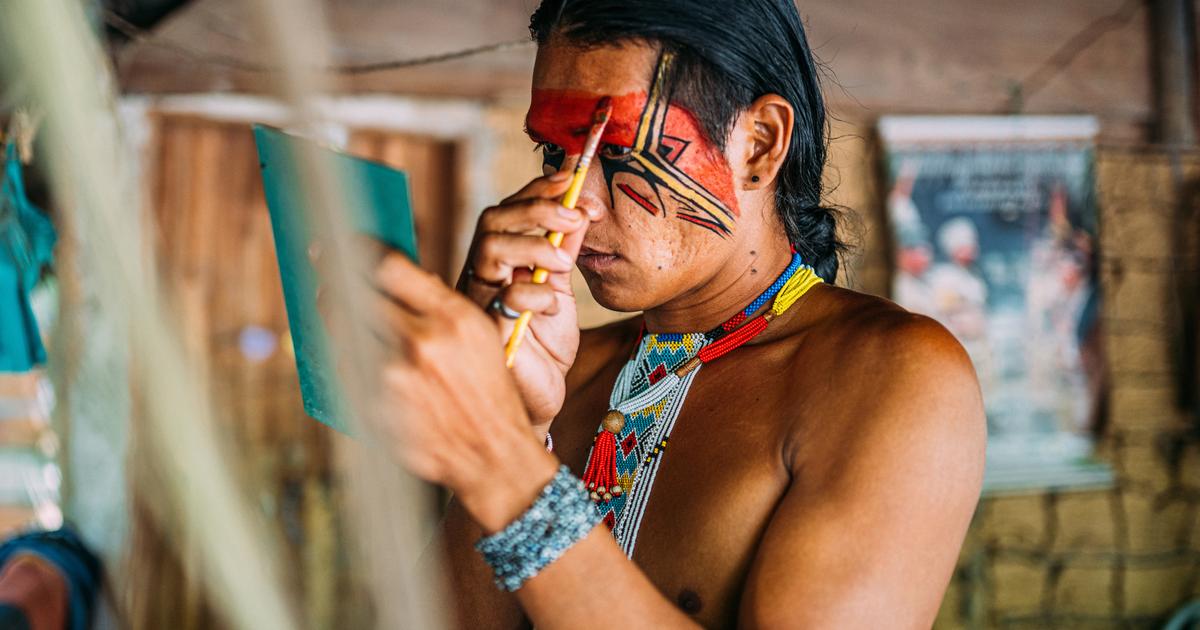How to tell your own story outside the Western gaze?
In the heart of the Colombian Amazon jungle, two indigenous peoples have discovered in documentary cinema a common language to bear witness to their culture.
In the San Martin de Amacayacu National Natural Park, Matis from Brazil and Tikuna from Colombia met at the end of October.
On the map, these two indigenous peoples live a few kilometers from each other, in the impenetrable jungles of this region where Colombia, Brazil and Peru meet on the banks of the majestic Amazon River.
For the Matis, it was a seven-day journey over torrential rivers and unlikely roads.
The Matis come from the Javari Valley, one of the most remote areas of the Brazilian Amazon, reputed to be very dangerous because of drug trafficking, fishing or illegal gold panning, and where the last populations would live
. uncontacted”
of the planet.
In June, the assassination of British journalist Dom Phillips and pro-indigenous activist Bruno Pereira who were investigating it made international headlines.
Owning his story
In 2015, the Matis were offered two cameras by Brazil's National Indigenous Foundation (FUNAI).
Supported by the Centro de Trabalho Indigenista (CTI), the initiative aimed to teach them to film, and especially to film themselves, in order to appropriate their own history.
The project was such a success that the Matis - recognizable by their tattooed faces - undertook, camera in hand, to go and convince their Tikuna neighbors to launch themselves into the documentary.
And the importance of building their own story, different from that of passing Westerners.
Read alsoAmazonia: Brazil tightens the noose on indigenous lands
“Contacted” for the first time by the outside world in 1976, the Matis have since tried to overcome this upheaval.
They quickly became
"the stars of exotic reporting"
by journalists from the United States, Japan, France or England, according to the CTI.
Foreigners were fascinated by their tattooed faces, their noses, ears and lips pierced with stems, bones or other ornaments, on copper-skinned bodies, covered with necklaces and bracelets.
“Many people came to the village, filmed without our permission and without us really understanding, before disappearing with their images and recordings
,” laments Pixi Kata Matis, a 29-year-old filmmaker, whose tattooed face evokes a feline.
In 2017, the Matis therefore went behind the camera themselves.
Tame the camera
In San Martin de Amacayacu, since the arrival of the
“jaguar men”
– a nickname due to the black ink that horizontally scratches the faces of the Matis – in this Colombian village of some 700 inhabitants, everything is only “satisfaction “And” curiosity “, told AFP Lizeth Reina, a 24-year-old Tikuna.
“We didn't know how to handle a camera.
They share their experience, come with their knowledge and their perseverance.
(…) We are very happy with this first step”
, rejoices in Spanish the young apprentice.
A Matis thus gives instructions on how to focus when shooting with the camera.
Communication is sometimes difficult, Matis and Tikunas not speaking the same vernacular... but the current, like the ideas, passes.
Read alsoIn the Amazon, the last Indian of Tanaru
They are ten to have come from the valley of Javari.
“It's not easy to get here, it's a bit of a hassle, but it's very exciting”
, smiles Pixi.
From hand to hand, we pass calabashes overflowing with "masato", a fermented drink made from cassava, tasted amidst laughter or twisting the mouth.
In the traditional “maloca”, community house made of wood and with a thatched roof, where the Tikunas gather all day long, the screening of Matis documentaries begins.
Seated in an onion row, kids on their knees, hundreds of spectators watch with admiration the hunt for blowguns, bows and arrows, as well as the "tattoo festival", a ritual that accompanies the passage from young Matis to adulthood.
Affirm your identity
The scenes inspire "respect", agree the Tikunas.
Films
"can help to leave memories for the future (...) so that we do not forget our traditions"
, judge Yina Moran, 17 years old.
"We have to show other peoples and white people that we have our identity," stresses Pixi.
The Tikunas intend to make three short films on seeds, medicinal plants and "masato", with the support of the CTI and a French association, ForestEver.
“The cameras were blended into the landscape and the families were more willing to share and communicate
,” notes Claire Davigo, coordinator of ForestEver.
In San Martin de Amacayacu, the wooden houses shelter families over several generations.
Helped by the Matis, the Tikuna film their daily life, interview the elders.
“The dialogue (with the Matis) was very beautiful.
Even though we barely speak Portuguese, we understand each other through our cultures,”
says Yina.
At the end of the afternoon, the heat fades, the villagers gather near the river, women do the laundry, others bathe.
The generators turn on at nightfall, only to turn off a few hours later.
Then begins the concert of the lush Amazonian jungle, recorded by cameras now held by Tikuna hands.

